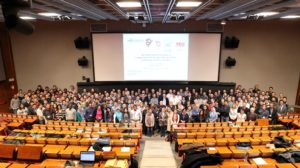Psi-k workshop on
“Atomic scale materials microscopy: theory meets experiment”
National Railway Museum, York (UK)
26-28 June 2017
Summary:
Atomic scale materials characterization is now one of the major drivers of technological innovation in areas such as nanoelectronics, catalysis, medicine, clean energy generation and energy storage. This can in a large part be attributed to advances in electron and scanning probe microscopies, which are now able to provide atomically resolved structural, chemical and electronic characterization of a wide range of functional materials. However, the types of systems relevant to applications, which include surfaces, interfaces, nanocrystals and two-dimensional materials, are complex and interpreting experimental images and spectra is often extremely challenging. On the other hand, parallel advances in theoretical approaches means that theory can often offer invaluable guidance. These approaches include first principles methods for structure prediction, simulation of scanning probe and electron microscopy images, and prediction of various spectroscopic signatures (e.g. EELS and STS). Some of the most impressive examples of this kind of research in recent years have combined complementary theoretical and experimental approaches in a synergistic way to unravel the complex structure of materials. This type of integrated approach is increasingly being recognised as critical to advanced materials research and development by both industry and research funders.
It was in this context that the Psi-k workshop: “Atomic scale materials microscopy: theory meets experiment” was held between the 26th and 28th of June 2017 at the National Railway Museum in York (UK). The scientific focus was on the application and development of first principles methods that, in synergy with advanced microscopy techniques (e.g. TEM, EELS, STM, AFM), can help to unravel the structure and properties of materials at the atomic scale. Open to both experts and newcomers the aim was to provide a rounded overview of emerging methods and challenges in the field, and provide an opportunity for in-depth discussion and exchange of ideas. Continue reading SCIENTIFIC REPORT ON THE PSI-K WORKSHOP: “ATOMIC SCALE MATERIALS MICROSCOPY: THEORY MEETS EXPERIMENT”









